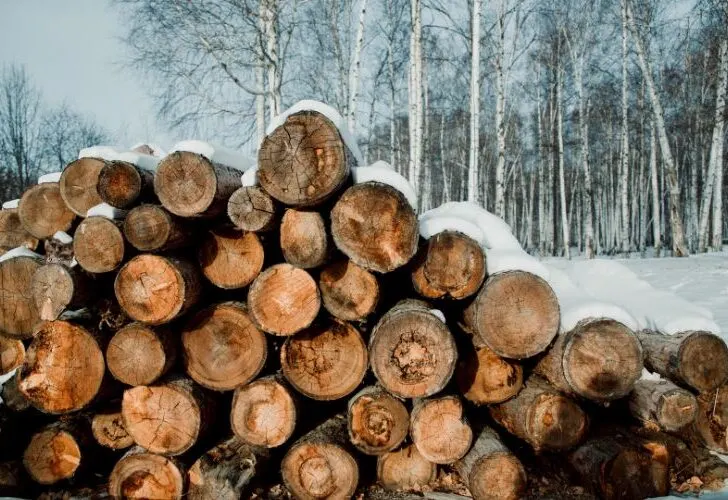Firewood storage is essential to keep the supply going during icy conditions when you can’t go out to get it.
It is not easy going into the forest to chop wood while it is snowing and cold. However, wood is an accessible energy source, and wood burning can supply enough heat to keep the cost spent on energy to a minimum.
However, firewood storage can be complex, especially during rainy seasons. It would help if you kept the wood pile dry so it doesn’t get damaged and become useless.
It also needs protection from pests and rodents that could damage it. The best and most common way to protect your wood pile is to cover it or keep it in a storage facility.
It would be best to cover a wood pile to protect it from weather elements such as snow and rain. They could make your wood damp and unable to burn. Therefore, you need to use a good cover that can prove absolute protection while allowing adequate air circulation.
Should I Cover My Firewood Pile?

It would be best if you covered your firewood pile to protect it from producing hazardous gases when you burn it.
Not covering your wood exposes it to moisture and makes it too damp to burn. If such wood burns eventually, it releases excessive thick, dark smoke, which contains methane and carbon monoxide.
A wet wood pile can also result in the growth of mold and rot, which causes damage to the wood.
Additionally, Leaving your wood pile without cover exposes it to pests and rodents. These pests and rodents eat the wood and decrease its value. It won’t allow the wood to last long when you use them.
You need to store the firewood pile in a dry place and cover it with a high-quality material that can effectively protect it. You should also leave enough space for ventilation to maintain the dryness.
However, you do not need to cover your firewood pile except if you are in a region with humidity.
You should open your wood to sunlight during summer and spring so that it can dry out. Sunlight and wind would help to remove all the moisture altogether.
You must pay attention to climate change to know when to cover your woodpile or not.
What Do You Put on Top of a Wood Pile?
During storage, you must use high-quality material to cover your wood pile. Any pile material should be water repellant, flexible, and allow proper ventilation to keep the wood dry.
In addition, it should be able to fully cover your woodpile and maintain its firmness during lousy weather. Different materials can achieve these goals.
Here is the list of materials you can put on top of a wood pile.
#1. Tarp
A tarp is the easiest and least expensive firewood cover. You can get a firewood tarp to cover your pile from a local hardware store around you.
A firewood tarp can protect your wood pile from snow and rain. It would be best to use a firewood tarp to cover only the top of the pile and let two inches of the tap hang out on the side.
It would help if you left the side of the stack uncovered to allow ventilation.
Furthermore, set some bricks and logs on the tarp’s edges to hold it. Finally, tie the tarp firmly with some bungee cord or rope.
However, there are some pros and cons of using a tarp.
| Pros | Cons |
|---|---|
| It is inexpensive and accessible. | It cannot withstand a rough storm. |
| It can effectively keep the firewood dry. | You need to stack your wood pile on a platform for this method to be efficient. |
| It gives enough room for airflow. | It doesn’t last long. |
#2. Commercial Firewood Cover
Commercial firewood covers protect your wood pile from snow and rain while allowing proper ventilation.
Most commercial firewood covers have air holes to allow adequate airflow after covering your pile completely. You can purchase the firewood cover from hardware stores.
#3. Firewood Cover Frame
It consists of a metal frame with a cover material over it. You can change the cover whenever it wears out or get damaged.
| Pros | Cons |
|---|---|
| You can replace the cover material as you desire. | It can’t stand rough weather. |
| You can make a cover frame out of any material. | It crashes under pressure. |
| It does not give your pile adequate protection. |
#4. Woodshed
It is the best cover option for your firewood pile. It has a roof and walls that can effectively protect your wood. Woodshed is also the most durable and long-lasting firewood cover.
| Pros | Cons |
|---|---|
| It offers complete protection to your wood pile. | It is expensive and requires carpentry skills to build. |
| It is durable and long-lasting. | It takes up a lot of space. |
| It can stand on its own without support. |
Why You Should Not Cover a Wood Pile?
You should not cover a wood pile if the wood is just freshly cut. The tarp cover would condense the wood and cause it to rot and mold.
Freshly cut wood contains moisture which facilitates the growth of molds. You do not need to protect fresh wood from snow or rain because there is still moisture in it; therefore, additional wetness won’t affect the wood.
In addition, you do not need to cover a wood pile during summer and spring. Firewood needs enough sunlight and wind to stay dry, so allow the pile to breathe during these seasons.
Also, you do not need to cover a wood pile except stay in a humid region. You should loosely cover the wood to allow air circulation in mild weather conditions.
How Do You Protect a Wood Pile?
You must use several methods to protect your wood pile from weather conditions, pests, and rodents. Firewood storage tips to use are;
#1. Outdoor Storage
It would be best to store firewood outside to control termite and rodent problems in your home. In addition, outdoor storage would allow proper air circulation in your pile.
It is also the best method if you do not have a shed or can’t store firewood inside your house. Always ensure to store your pile away from trees and bushes.
#2. Covering
Covering the wood pile with a covering material is essential when you store them outside.
However, you should avoid covering the pile ultimately to allow airflow. You should also use a weatherproof cover to keep your wood dry.
#3. Location
It would help if you did not store your pile on the soil because it lets moisture sneak into the wood and causes mold growth and rot.
Instead, you can stack the pile on a platform or well-drained gravel to protect it. For example, you can build a platform from trees and treated wood.
You should also ensure the wood pile is at least four inches above the ground.
#4. Stacking
It would help if you stacked your pile uniformly to create space for more wood. It would also give less room for rodents to hide. In addition, a uniform stack would not collapse easily.
#5. Pest Control
You need to keep the storage area clean and remove weeds, grasses, and discarded dirt from the area. Disinfect the storage area before stacking your wood pile.
You should always use the older wood before the new ones. Avoid storing wood with bark. Remove the bark to prevent a breeding ground for termites and bacteria.
Firewood Cover Vs. Not Covered
You do not need to cover some wood types because they can damage them. Likewise, there are advantages to covering wood piles.
However, you need to understand the types of wood to know if they need firewood cover.
#1. Fresh Firewood
You should not cover freshly cut firewood and allow them to dry completely. A cover would condense the wood and cause it to rot. It would be best if you only covered them when the pile is completely dry.
#2. Seasoned Firewood
It would be best if you covered seasoned and dry firewood to protect them from getting wet. Dampness won’t allow your wood to burn.
Conclusion
It is best to cover your firewood pile in any weather to protect it from elements of nature. Always cut wood logs into pieces to keep them dry.
Also, it is essential to always give space for air circulation in any storage system you choose.
References:





